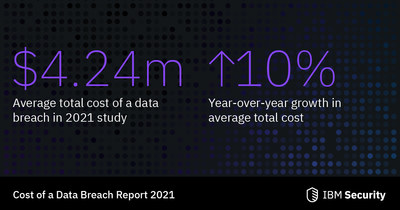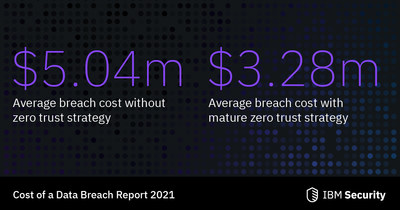IBM Report: Cost of a Data Breach Hits Record High During Pandemic
The 2021 Cost of a Data Breach Report by IBM reveals that data breaches now average $4.24 million per incident, the highest in 17 years, reflecting a 10% increase since last year. The report highlights the impact of remote work, which raises breach costs by over $1 million. Healthcare breaches are the most expensive, averaging $9.23 million. However, businesses adopting AI, hybrid cloud, and zero trust approaches reported reduced costs, saving up to $1.49 million. Organizations that modernized their security measures were better positioned to handle breaches efficiently.
- Adoption of AI, security analytics, and encryption reduced breach costs by $1.25 million to $1.49 million.
- Organizations with a mature zero trust strategy had average breach costs of $3.28 million, $1.76 million lower than those without.
- Companies that deployed security automation reduced average breach costs to $2.90 million compared to $6.71 million for those without automation.
- Average breach cost reached $4.24 million, a 10% increase from last year, indicating a worsening financial impact.
- Healthcare sector experienced the highest breach costs at $9.23 million, a $2 million increase from previous year.
- Breaches linked to remote work cost companies $4.96 million, nearly 15% more than average.
- Data breaches cost surveyed companies
$4.24 million per incident on average; highest in 17-year report history - Adoption of AI, hybrid cloud, and zero trust approach lowered data breach costs
CAMBRIDGE, Mass., July 28, 2021 /PRNewswire/ -- IBM (NYSE: IBM) Security today announced the results of a global study which found that data breaches now cost surveyed companies
Businesses were forced to quickly adapt their technology approaches last year, with many companies encouraging or requiring employees to work from home, and
The annual Cost of a Data Breach Report, conducted by Ponemon Institute and sponsored and analyzed by IBM Security, identified the following trends amongst the organizations studied:
- Remote work impact: The rapid shift to remote operations during the pandemic appears to have led to more expensive data breaches. Breaches cost over
$1 million more on average when remote work was indicated as a factor in the event, compared to those in this group without this factor ($4.96 vs.$3.89 million .)2
- Healthcare breach costs surged: Industries that faced huge operational changes during the pandemic (healthcare, retail, hospitality, and consumer manufacturing/distribution) also experienced a substantial increase in data breach costs year over year. Healthcare breaches cost the most by far, at
$9.23 million per incident – a$2 million increase over the previous year.
- Compromised credentials led to compromised data: Stolen user credentials were the most common root cause of breaches in the study. At the same time, customer personal data (such as name, email, password) was the most common type of information exposed in data breaches – with
44% of breaches including this type of data. The combination of these factors could cause a spiral effect, with breaches of username/passwords providing attackers with leverage for additional future data breaches.
- Modern approaches reduced costs: The adoption of AI, security analytics, and encryption were the top three mitigating factors shown to reduce the cost of a breach, saving companies between
$1.25 million and$1.49 million compared to those who did not have significant usage of these tools. For cloud-based data breaches studied, organizations that had implemented a hybrid cloud approach had lower data breach costs ($3.61m ) than those who had a primarily public cloud ($4.80m ) or primarily private cloud approach ($4.55m ).
"Higher data breach costs are yet another added expense for businesses in the wake of rapid technology shifts during the pandemic," said Chris McCurdy, Vice President and General Manager, IBM Security. "While data breach costs reached a record high over the past year, the report also showed positive signs about the impact of modern security tactics, such as AI, automation and the adoption of a zero trust approach – which may pay off in reducing the cost of these incidents further down the line."
Impact of Remote Work and Shift to Cloud on Data Breaches
With society leaning more heavily on digital interactions during the pandemic, companies embraced remote work and cloud as they shifted to accommodate this increasingly online world. The report found that these factors had a significant impact on data breach response. Nearly
Companies in the study that experienced a breach during a cloud migration project had
Compromised Credentials a Growing Risk
The report also shed light on a growing problem in which consumer data (including credentials) is being compromised in data breaches, which can then be used to propagate further attacks. With
- Personal Data Exposed: Nearly half (
44% ) of the breaches analyzed exposed customer personal data, such as name, email, password, or even healthcare data – representing the most common type of breached record in the report. - Customer PII Most Costly: The loss of customer personal identifiable information (PII) was also the most expensive compared to other types of data (
$180 per lost or stolen record vs$161 for overall per record average). - Most Common Attack Method: Compromised user credentials were the most common method used as an entry point by attackers, representing
20% of breaches studied. - Longer to Detect & Contain: Breaches resulting from compromised credentials took the longest to detect – taking an average of 250 days to identify (vs. 212 for the average breach.)
Businesses That Modernized Had Lower Breach Costs
While certain IT shifts during the pandemic increased data breach costs, organizations who said they did not implement any digital transformation projects in order to modernize their business operations during the pandemic actually incurred higher data breach costs. The cost of a breach was
Companies studied that adopted a zero trust security approach were better positioned to deal with data breaches. This approach operates on the assumption that user identities or the network itself may already be compromised, and instead relies on AI and analytics to continuously validate connections between users, data and resources. Organizations with a mature zero trust strategy had an average data breach cost of
The report also found that more companies were deploying security automation compared to prior years, leading to significant cost savings. Around
Investments in incident response teams and plans also reduced data breach costs amongst those studied. Companies with an incident response team that also tested their incident response plan had an average breach cost of
Additional findings from the 2021 report include:
- Time to respond: The average time to detect and contain a data breach was 287 days (212 to detect, 75 to contain) – which is one week longer than the prior year report.
- Mega breaches: Average cost of a mega breach was
$401 million , for breaches between 50 million and 65 million records.3 This is nearly 100x more expensive than the majority of breaches studied in the report (which ranged from 1,000-100,000 records.) - By industry: Data breaches in healthcare were most expensive by industry (
$9.23m ), followed by the financial sector ($5.72m ) and pharmaceuticals ($5.04m ). While lower in overall costs, retail, media, hospitality and public sector experienced a large increase in costs vs. the prior year. - By country/region: The US had the most expensive data breaches at
$9.05 million per incident, followed by Middle East ($6.93m ) and Canada ($5.4m ).
Methodology and Additional Data Breach Statistics
The 2021 Cost of a Data Breach Report from IBM Security and Ponemon Institute is based on in-depth analysis of real-world data breaches of 100,000 records or less, experienced by over 500 organizations worldwide between May 2020 and March 2021. The report takes into account hundreds of cost factors involved in data breach incidents, from legal, regulatory and technical activities to loss of brand equity, customers, and employee productivity.
To download a copy of the 2021 Cost of a Data Breach Report, please visit: ibm.com/databreach
Sign up for the 2021 Cost of a Data Breach Report webinar on August 18 at 11:00 AM ET, here: ibm.biz/CODBwebinar
About IBM Security
IBM Security offers one of the most advanced and integrated portfolios of enterprise security products and services. The portfolio, supported by world-renowned IBM Security X-Force® research, enables organizations to effectively manage risk and defend against emerging threats. IBM operates one of the world's broadest security research, development and delivery organizations, monitors 150 billion+ security events per day in more than 130 countries, and has been granted more than 10,000 security patents worldwide. For more information, please check www.ibm.com/security, follow @IBMSecurity on Twitter or visit the IBM Security Intelligence blog.
Media Contact:
Cassy Lalan
Media Relations, IBM Security
319-230-2232 (m)
cllalan@us.ibm.com
1 IBM Institute for Business Value: COVID-19 and the future of business
2 Average cost of
3 The 2021 Cost of a Data Breach Report examines the cost of a mega breach based on a separate analysis of a specific sample involving loss or theft of one million records or more. The mega breach sample is not included in the overall average data breach report calculations, which examines data breaches ranging from 1,000-100,000 records.
![]() View original content to download multimedia:https://www.prnewswire.com/news-releases/ibm-report-cost-of-a-data-breach-hits-record-high-during-pandemic-301342720.html
View original content to download multimedia:https://www.prnewswire.com/news-releases/ibm-report-cost-of-a-data-breach-hits-record-high-during-pandemic-301342720.html
SOURCE IBM
FAQ
What is the average cost of a data breach according to IBM's report?
How much do healthcare data breaches cost on average?
What factors increased the cost of data breaches?
What security measures helped reduce breach costs?











